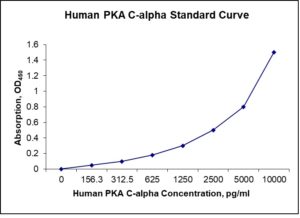Nori Human PKA C alpha ELISA Kit
$461.00 – $832.00
This ELISA kit is for quantification of PKACA in human. This is a quick ELISA assay that reduces time to 50% compared to the conventional method, and the entire assay only takes 3 hours. This assay employs the quantitative sandwich enzyme immunoassay technique and uses biotin-streptavidin chemistry to improve the performance of the assays. An antibody specific for PKACA has been pre-coated onto a microplate. Standards and samples are pipetted into the wells and any PKACA present is bound by the immobilized antibody. After washing away any unbound substances, a detection antibody specific for PKACA is added to the wells. Following wash to remove any unbound antibody reagent, a detection reagent is added. After intensive wash a substrate solution is added to the wells and color develops in proportion to the amount of PKACA bound in the initial step. The color development is stopped, and the intensity of the color is measured.
Alternative names for PKA C alpha: cAMP-dependent protein kinase catalytic subunit alpha (PKA C alpha, PRKACA), PKACA
This product is for Laboratory Research Use Only not for diagnostic and therapeutic purposes or any other purposes.
- Description
- How Elisa Works
- Product Citation (0)
- Reviews (0)
Description
Nori Human PKA C alpha ELISA Kit Summary
Alternative names for PKA C alpha: cAMP-dependent protein kinase catalytic subunit alpha (PKA C alpha, PRKACA), PKACA
| Assay Type | Solid Phase Sandwich ELISA |
| Format | 96-well Microplate or 96-Well Strip Microplate |
| Method of Detection | Colorimetric |
| Number of Targets Detected | 1 |
| Target Antiben Accession Number | P17612 |
| Assay Length | 3 hours |
| Quantitative/Semiquantitative | Quantitative |
| Sample Type | Plasma, Serum, Cell Culture, Urine, Cell/Tissue Lysates, Synovial Fluid, BAL, |
| Recommended Sample Dilution (Plasma/Serum) | No dilution for sample <ULOQ; sufficient dilution for samples >ULOQ |
| Sensitivity | 30 pg/mL |
| Detection Range | 0.156-10 ng/mL |
| Specificity | Human PKACA |
| Cross-Reactivity | < 0.5% cross-reactivity observed with available related molecules, < 50% cross-species reactivity observed with species tested. |
| Interference | No significant interference observed with available related molecules |
| Storage/Stability | 4 ºC for up to 6 months |
| Usage | For Laboratory Research Use Only. Not for diagnostic or therapeutic use. |
| Additional Notes | The kit allows for use in multiple experiments. |
Standard Curve
Kit Components
1. Pre-coated 96-well Microplate
2. Biotinylated Detection Antibody
3. Streptavidin-HRP Conjugate
4. Lyophilized Standards
5. TMB One-Step Substrate
6. Stop Solution
7. 20 x PBS
8. Assay Buffer
Other Materials Required but not Provided:
1. Microplate Reader capable of measuring absorption at 450 nm
2. Log-log graph paper or computer and software for ELISA data analysis
3. Precision pipettes (1-1000 µl)
4. Multi-channel pipettes (300 µl)
5. Distilled or deionized water
Protocol Outline
1. Prepare all reagents, samples and standards as instructed in the datasheet.
2. Add 100 µl of Standard or samples to each well and incubate 1 h at RT.
3. Add 100 µl of Working Detection Antibody to each well and incubate 1 h at RT.
4. Add 100 µl of Working Streptavidin-HRP to each well and incubate 20 min at RT.
5. Add 100 µl of Substrate to each well and incubate 5-30 min at RT.
6. Add 50 µl of Stop Solution to each well and read at 450 nm immediately.
Background:
cAMP-dependent protein kinase catalytic subunit alpha (PKA C alpha, PRKACA) is an enzyme that in humans is encoded by the PRKACA gene.[1] cAMP is a signaling molecule important for a variety of cellular functions. cAMP exerts its effects by activating the Protein kinase A (PKA), which transduces the signal through phosphorylation of different target proteins. The inactive holoenzyme of PKA is a tetramer composed of two regulatory and two catalytic subunits. cAMP causes the dissociation of the inactive holoenzyme into a dimer of regulatory subunits bound to four cAMP and two free monomeric catalytic subunits. Four different regulatory subunits and three catalytic subunits of AMPK have been identified in humans. PRKACA is a member of the Ser/Thr protein kinase family and is a catalytic subunit of AMPK. Alternatively spliced transcript variants encoding distinct isoforms have been observed. PRKACA has been shown to interact with Phosphoinositide-dependent kinase-1,[2] IQGAP1,[3] KvLQT1[4] and Ryanodine receptor 2.[5] PRKACA Phosphorylates CDC25B, ABL1, NFKB1, CLDN3, PSMC5/RPT6, PJA2, RYR2, RORA and VASP. It is required for glucose-mediated adipogenic differentiation increase and osteogenic differentiation inhibition from osteoblasts. PRKACA prevents the antiproliferative and anti-invasive effects of alpha-difluoromethylornithine in breast cancer cells when activated. It negatively regulates tight junctions (TJs) in ovarian cancer cells via CLDN3 phosphorylation. Prevents meiosis resumption in prophase-arrested oocytes via CDC25B inactivation by phosphorylation.
References
- Tasken K, et al. (1997). Genomics 36 (3): 535–8.
- Biondi, R M; et al. (2000). EMBO J. (ENGLAND) 19 (5): 979–88.
- Nauert, J Brian et al. (2003). Cell. Biochem. (United States) 90 (1): 97–108.
- Marx, Steven O; et al. (2002). Science (United States) 295 (5554): 496–9.
- Marx, S O; et al. (2000). Cell (UNITED STATES) 101 (4): 365–76.
Be the first to review “Nori Human PKA C alpha ELISA Kit”
You must be logged in to post a review.




























Reviews
There are no reviews yet.